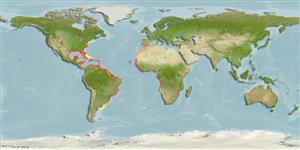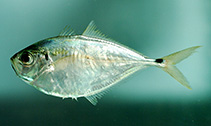Chloroscombrus chrysurus (Linnaeus, 1766)
Atlantic bumper
添加你自己的观测位置在 Fish Watcher
| Native range | All suitable habitat | Point map | Year 2050 |

|
| This map was computer-generated and has not yet been reviewed. |
| Chloroscombrus chrysurus AquaMaps Data sources: GBIF OBIS |
Common names from other countries
分类 / Names 俗名 | 同种异名 | Catalog of Fishes(属, 种) | ITIS | CoL | WoRMS | Cloffa
Teleostei > Carangiformes (Jacks) 鱸形目 (Jacks) > Carangidae (Jacks and pompanos) > Caranginae
Etymology: Chloroscombrus: Greek, chloros = green + Greek, skombros = the name of several fishes, a mackerel (Ref. 45335).
More on author: Linnaeus.
Etymology: Chloroscombrus: Greek, chloros = green + Greek, skombros = the name of several fishes, a mackerel (Ref. 45335).
More on author: Linnaeus.
Environment: milieu / climate zone / depth range / distribution range 生态学
海洋; 半咸淡水; 深度上下限 0 - 110 m (Ref. 114025). 亞熱帶的; 42°N - 41°S, 98°W - 14°E
分布 国家 | FAO区域 | 生态系 | 标本纪录 | Point map | 简介 | Faunafri
Western Atlantic: Massachusetts to Florida, USA and Bermuda to Uruguay; throughout Caribbean Sea and Gulf of Mexico (Ref. 9626); Bahamas, Antilles, along Central and South American coasts to Uruguay (Ref. 26938). Eastern Atlantic: Spain to Angola (Ref. 57392). First recorded from the Mediterranean Sea (Ref. 128468).
Replaced by Chloroscombrus orqueta in eastern Pacific. These two species have not been adequately studied and may prove to be conspecific.
西大西洋: 麻薩諸塞州到美國的佛羅里達與百慕達群島到烏拉圭; 在加勒比海與墨西哥灣各處;(參考文獻 9626) 巴哈馬 , 安地列斯群島, 沿著中央的與南美洲岸邊到烏拉圭.(參考文獻 26938) 東大西洋: 茅利塔尼亞到安哥拉。 在東太平洋中被 Chloroscombrus orqueta 取代了。 這兩個種沒有足夠地被研究而且可能證明是同種的。
西大西洋: 麻薩諸塞州到美國的佛羅里達與百慕達群島到烏拉圭; 在加勒比海與墨西哥灣各處;(參考文獻 9626) 巴哈馬 , 安地列斯群島, 沿著中央的與南美洲岸邊到烏拉圭.(參考文獻 26938) 東大西洋: 茅利塔尼亞到安哥拉。 在東太平洋中被 Chloroscombrus orqueta 取代了。 這兩個種沒有足夠地被研究而且可能證明是同種的。
Length at first maturity / 大小 / 重量 / 年龄
Maturity: Lm 12.4, range 10 - ? cm
Max length : 65.0 cm TL 雄鱼/尚未辨别雌雄; (Ref. 57392); common length : 25.0 cm TL 雄鱼/尚未辨别雌雄; (Ref. 5217); 最大体重: 121.00 g (Ref. 128468)
Max length : 65.0 cm TL 雄鱼/尚未辨别雌雄; (Ref. 57392); common length : 25.0 cm TL 雄鱼/尚未辨别雌雄; (Ref. 5217); 最大体重: 121.00 g (Ref. 128468)
简单描述 检索表 | 型态特徵 | 形态测量图
背棘 (总数) : 9; 背的软条 (总数) : 25 - 28; 臀棘: 3; 臀鳍软条: 25 - 28. Diagnosis: body compressed and deep (depth comprised from 2.3 to 2.8 times in fork length) (Ref. 57392), its ventral profile distinctly more convex than the dorsal (Ref. 26938, 57392). Snout very short, its tip blunt, upper jaw extending almost to behind level of anterior eye margin; 2 dorsal fins, the first with 8 spines, the second with 1 spine and 25-28 soft rays; anal fin with 2 detached spines, followed by 1 spine and 25-28 soft rays; upper lobe of caudal fin longer than the lower; small, cycloid scales covering most of body, including chest; 5-15 weak scutes on posterior part of lateral line, at level of caudal peduncle, the latter without bilateral keels (Ref. 57392). Metallic blue above, silvery below; caudal peduncle with black saddle spot (Ref. 3197).
Coloration: back greenish or bluish, sides silvery-white; a dark, saddle-shaped blotch on caudal peduncle just before caudal fin, and another at upper angle of gill cover (Ref. 57392).
铁蓝色的上方, 下面银色的; 尾梗有黑色的斑点。 (参考文献 3197) 低的轮廓更多的强烈弯曲超过上面的。 (参考文献 26938).
铁蓝色的上方, 下面银色的; 尾梗有黑色的斑点。 (参考文献 3197) 低的轮廓更多的强烈弯曲超过上面的。 (参考文献 26938).
Adults are found over soft bottoms of the continental shelf; sometimes forming schools near the surface (Ref. 5217). Marine pelagic species very common in coastal lagoons and estuaries (Ref. 57392). They feed on fish, cephalopods, zooplankton and detritus (Ref. 28587). Juveniles common in brackish estuaries and often associated with jellyfish (Ref. 5217). Marketed fresh and salted.
发现在大陆架的软质底部上了; 有时形成群体接近水表面。 (参考文献 5217) 吃鱼,头足类动物,浮游动物与碎屑。 (参考文献 28587) 稚鱼常见于半咸淡的河口 (参考文献 5217) 与时常伴随着水母。 在市场上销售生鲜地了与盐腌的。
发现在大陆架的软质底部上了; 有时形成群体接近水表面。 (参考文献 5217) 吃鱼,头足类动物,浮游动物与碎屑。 (参考文献 28587) 稚鱼常见于半咸淡的河口 (参考文献 5217) 与时常伴随着水母。 在市场上销售生鲜地了与盐腌的。
Life cycle and mating behavior 成熟度 | 繁殖 | 产卵场 | 卵 | 孕卵数 | 仔鱼
西大西洋: 麻薩諸塞州到美國的佛羅里達與百慕達群島到烏拉圭; 在加勒比海與墨西哥灣各處;(參考文獻 9626) 巴哈馬 , 安地列斯群島, 沿著中央的與南美洲岸邊到烏拉圭.(參考文獻 26938) 東大西洋: 茅利塔尼亞到安哥拉。 在東太平洋中被 Chloroscombrus orqueta 取代了。 這兩個種沒有足夠地被研究而且可能證明是同種的。
主要参考文献
Upload your references | 参考文献 | 合作者 : Smith-Vaniz, William F. | 合作者
Smith-Vaniz, W.F., J.-C. Quéro and M. Desoutter, 1990. Carangidae. p. 729-755. In J.C. Quero, J.C. Hureau, C. Karrer, A. Post and L. Saldanha (eds.) Check-list of the fishes of the eastern tropical Atlantic (CLOFETA). JNICT, Lisbon; SEI, Paris; and UNESCO, Paris. Vol. 2. (Ref. 7097)
对人类的威胁
无害处的
人类利用
渔业: 商业性
FAO(渔业: 产生; publication : search) | FishSource | 周边海洋
更多信息
Population dynamics
成长参数
Max. ages / sizes
Length-weight rel.
Length-length rel.
体长-频率
Mass conversion
入添量
丰度
成长参数
Max. ages / sizes
Length-weight rel.
Length-length rel.
体长-频率
Mass conversion
入添量
丰度
Anatomy
鳃区
Brain
Otolith
鳃区
Brain
Otolith
Physiology
Body composition
Nutrients
耗氧量
游泳类型
游泳速度
Visual pigments
Fish sound
Diseases & Parasites
Toxicity (LC50s)
Body composition
Nutrients
耗氧量
游泳类型
游泳速度
Visual pigments
Fish sound
Diseases & Parasites
Toxicity (LC50s)
工具
E-book | 野外调查 | 检索表 | 长度- 频率 Wizard | 生活- 历史的工具 | 分布图 | Classification Tree
| Catch-MSY |
特别资料
下载 XML
网络资源
Aquatic Commons | BHL | Cloffa | Websites from users | 核实 FishWatcher | CISTI | Catalog of Fishes(属, 种) | DiscoverLife | ECOTOX | Faunafri | Fishtrace | GenBank(基因组, 核苷酸) | GloBI | GOBASE | GoMexSI (interaction data) | | Google Books | Google Scholar | Google | IGFA World Record | MitoFish | 国家资料库 | Otolith Atlas of Taiwan Fishes | PubMed | Reef Life Survey | Scirus | SeaLifeBase | 树状分类阶层 | Wikipedia(转至, 搜寻) | World Records Freshwater Fishing | 动物学的记录
Estimates based on models
Preferred temperature (Ref. 115969): 23.2 - 28, mean 26.2 (based on 552 cells).
Phylogenetic diversity index (Ref. 82804): PD50 = 0.7500 [Uniqueness, from 0.5 = low to 2.0 = high].
Bayesian length-weight: a=0.01230 (0.01090 - 0.01389), b=2.94 (2.91 - 2.97), in cm Total Length, based on LWR estimates for this species (Ref. 93245).
营养阶层 (Ref. 69278): 3.5 ±0.2 se; based on diet studies.
回复力 (Ref. 120179): 中等的, 族群倍增时间最少 1.4 - 4.4年 (K=0.22-0.56).
Prior r = 0.57, 95% CL = 0.37 - 0.85, Based on 3 data-limited stock assessments.
Fishing Vulnerability (Ref. 59153): Low to moderate vulnerability (29 of 100).
Climate Vulnerability (Ref. 125649): High to very high vulnerability (75 of 100).




